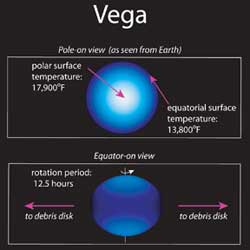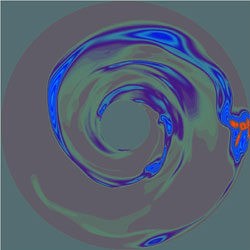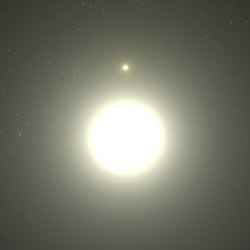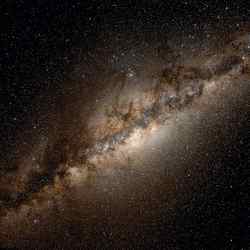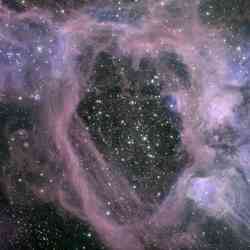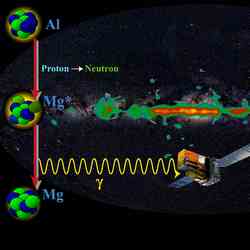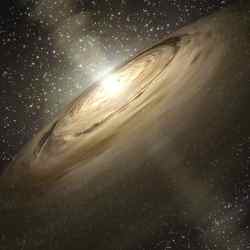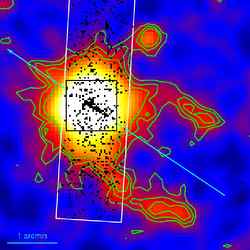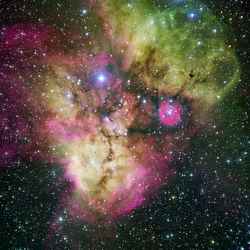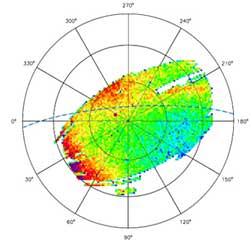
Distribution of stars in galactic companion. Image credit: PSU. Click to enlarge.
A team of scientists from the Sloan Digital Sky Survey (SDSS), including a Penn State astrophysicist, has discovered a companion to the Milky Way galaxy that is so big it previously had been undetectable. The result is the topic of a press conference during the meeting of the American Astronomical Society now taking place in Washington, D.C.
The study, lead by Mario Juric of Princeton and Zeljko Ivezic of the University of Washington, found a collection of stars in the constellation Virgo that covers nearly 5,000 times the size of the full moon. Penn State Professor of Astronomy and Astrophysics Donald Schneider, a coauthor of the investigation, is the Chairman of the SDSS Quasar Science Group and the SDSS Scientific Publications Coordinator. “The star cluster is located only 30,000 light years from Earth,” noted Schneider. “This is the same distance from us as is the Galactic Center, although the cluster lies in a different direction from the Center. It is likely that the cluster is the remnant of a small galaxy that has been captured and disrupted by the gravitational field of our galaxy.”
The galaxy is a huge but very faint structure, containing hundreds of thousands of stars spread over an area area nearly 5,000 times the size of a full moon. Although the structure lies well within the confines of the Milky Way Galaxy, at an estimated distance of 30,000 light years from Earth, it does not follow any of Milky Way’s three main components: a flattened disk of stars in which the Sun resides, a bulge of stars at the center of the Galaxy, and an extended, roughly spherical, stellar halo. Instead, the discoverers believe that the most likely interpretation of the new structure is a dwarf galaxy that is merging into the Milky Way.
“Some of the stars in this Milky Way companion have been seen with telescopes for centuries,” explained Princeton University graduate student Mario Juric, who is principal author of the journal article describing what may well be our closest galactic neighbor. “But because the galaxy is so close, its stars are spread over a huge swath of the sky, and they always used to be lost in the sea of more numerous Milky Way stars. This galaxy is so big, we couldn’t see it before.”
The discovery was made possible by the unprecedented depth and photometric accuracy of the SDSS, which to date has imaged roughly 1/4 of the northern sky. “We used the SDSS data to measure distances to 48 million stars and build a 3-D map of the Milky Way,” explained Zeljko Ivezic of the University of Washington, a co-author of the study. Details of this “photometric parallax” method, which uses the colors and apparent brightnesses of stars to infer their distances, are explained in a paper titled “Milky Way Tomography,” submitted to The Astrophysical Journal.
“It’s like looking at the Milky Way with a pair of 3-d glasses,” said Princeton University co-author Robert Lupton. “This structure that used to be lost in the background suddenly snapped into view.” The new result is reminiscent of the 1994 discovery of the Sagittarius dwarf galaxy, by Rodrigo Ibata and collaborators from Cambridge University. They used photographic images of the sky to identify an excess of stars on the far side of the Milky Way, some 75,000 light years from Earth. The Sagittarius dwarf is slowly dissolving, trailing streams of stars behind it as it orbits the Milky Way and sinks into the Galactic disk.
In the ensuing decade, a new generation of sky surveys using large digital cameras has identified numerous streams and lumps of stars in the outer Milky Way. Some of these lumps are probably new Milky Way companions, while others may be shreds of the Sagittarius dwarf or of other dissolving dwarf galaxies. Earlier SDSS discoveries include an apparent ring of stars that encircles the Milky Way disk and may be the remnant of another disrupted galaxy, and the Ursa Major dwarf, the faintest known neighbor of the Milky Way.
Preliminary evidence for the new dwarf galaxy, found toward the constellation Virgo, appeared in maps of variable stars by the SDSS and by the QUEST survey (a Yale University/University of Chile collaboration). “With so much irregular structure in the outer Galaxy, it looks as though the Milky Way is still growing, by cannibalizing smaller galaxies that fall into it,” said Juric.
Another group of SDSS astronomers, led by Daniel Zucker of the Max Planck Institute of Astronomy in Heidelberg and Cambridge University’s Institute of Astronomy, has used the SDSS to find the two faintest known companions of the Andromeda Galaxy, which is the closest giant spiral galaxy similar in size to the Milky Way. “These new Andromeda companions, alongside the new Milky Way neighbors, suggest that faint satellite galaxies may be plentiful in the Local Group,” said Zucker.
While the SDSS originally was designed to study the distant universe, its wide area, high precision maps of faint stars have made it an invaluable tool for studying the Milky Way and its immediate neighborhood. The 3-D map created by Juric and his collaborators also provides strong new constraints on the shape and extent of the Milky Way’s disk and stellar halo. Another Princeton graduate student, Nick Bond, is using the subtle motions of stars detected over the 5-year span of the SDSS observations to limit the amount of dark matter in the solar neighborhood. University of Washington graduate student Jillian Meyer is mapping the distribution of interstellar dust carefully studying the colors of stars found in both the SDSS and the infrared 2MASS survey.
Building on these many successes, the SEGUE project (Sloan Extension for Galactic Understanding and Exploration) will use the SDSS telescope, its 120-megapixel digital camera, and its 640-fiber optical spectrograph to carry out detailed studies of the structure and chemical evolution of the Milky Way. SEGUE is one of three components of SDSS-II, the three-year extension of the Sloan Survey that will run through mid-2008.
Fermilab scientist Brian Yanny, one of the SEGUE team leaders, is excited at the prospect of examining its just-completed, first season of observations. “The SDSS has already told us surprising things about the Milky Way, but the most exciting discoveries should lie just ahead.”
Funding for the SDSS and SDSS-II has been provided by the Alfred P. Sloan Foundation, the Participating Institutions, the National Science Foundation, the U.S. Department of Energy, the National Aeronautics and Space Administration, the Japanese Monbukagakusho, the Max Planck Society, and the Higher Education Funding Council for England. The SDSS Web Site is http://www.sdss.org/.
The SDSS is managed by the Astrophysical Research Consortium for the Participating Institutions, which include the American Museum of Natural History, Astrophysical Institute Potsdam, University of Basel, Cambridge University, Case Western Reserve University, University of Chicago, Drexel University, Fermilab, the Institute for Advanced Study, the Japan Participation Group, Johns Hopkins University, the Joint Institute for Nuclear Astrophysics, the Kavli Institute for Particle Astrophysics and Cosmology, the Korean Scientist Group, the Chinese Academy of Sciences (LAMOST), Los Alamos National Laboratory, the Max-Planck-Institute for Astronomy (MPA), the Max-Planck-Institute for Astrophysics (MPIA), New Mexico State University, Ohio State University, University of Pittsburgh, University of Portsmouth, Princeton University, the United States Naval Observatory, and the University of Washington.
Original Source: Eberly College News Release

